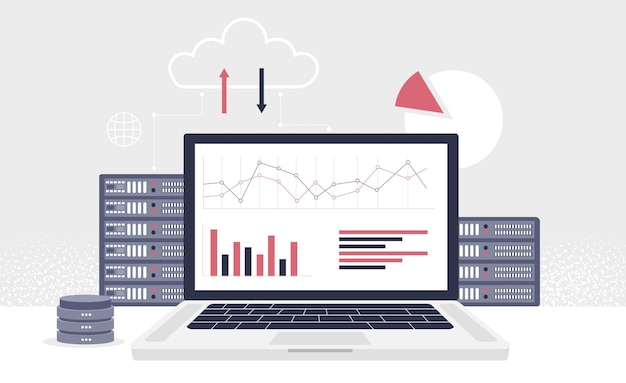Are you still relying on manual methods to gather data for your projects?
In today’s data-driven world, that approach can be incredibly limiting.
Enter Python data extraction tools—your key to unlocking endless possibilities with efficient, automated data collection.
From web scraping to utilizing APIs, these powerful libraries, like Beautiful Soup and Scrapy, enable developers to extract and manipulate data with ease, boosting productivity and driving insights.
In this article, we’ll explore the landscape of Python data extraction tools, their unique benefits, and why they should be a cornerstone of your data strategy.
Python Data Extraction Tools: Overview of the Landscape
Python boasts a variety of libraries and tools dedicated to data extraction, capable of addressing diverse needs in data management tasks such as web scraping, data mining, and API access.
Key libraries in the python data extraction tools landscape include:
-
Beautiful Soup: This library excels in parsing HTML and XML documents, making it ideal for web scraping with Python. It simplifies navigating and searching through complex document structures, allowing for easy extraction of required data.
-
Scrapy: A powerful framework designed for large-scale web scraping projects, Scrapy is equipped with built-in capabilities for handling requests, following links, and managing data pipelines efficiently. It is particularly suitable for extracting large volumes of data and automating the scraping process.
-
Pandas: While primarily known for data manipulation, Pandas also serves as an excellent tool for data extraction from various formats, including CSV, Excel, and SQL databases. Its data frame abstraction makes it easy to clean and analyze the extracted information.
-
Requests: Simplifying HTTP requests, Requests is fundamental for web scraping with Python. It allows seamless interaction with web pages and APIs, enabling users to retrieve and interact with data effortlessly.
These tools not only enhance the process of data extraction but also ensure that users can extract, manage, and analyze information with efficiency and ethical consideration. The effectiveness of python libraries for data extraction lies in their ability to adapt to various data sources while providing the necessary functionalities to handle complex tasks.
Key Python Libraries for Data Extraction
Python offers a rich ecosystem of libraries tailored for data extraction, each serving distinct purposes.
Beautiful Soup
Funkcjonalność: Beautiful Soup is a powerful library for parsing HTML and XML documents.
Instalacja: Można go zainstalować za pomocą pip:
“`bash
pip install beautifulsoup4
*Porady użytkowe*: Idealnie nadaje się do prostej ekstrakcji danych z witryn internetowych. Można używać go w połączeniu z Requests do pobierania HTML i następnie przetwarzania go.
**Scrapy**
*Funkcjonalność*: Scrapy to framework zaprojektowany specjalnie do większych projektów związanych z web scrapingiem, obsługujący asynchroniczne żądania.
*Instalacja*: Instalacja również z pip:
bash
pip install scrapy
*Porady użytkowe*: Dobrze sprawdza się w projektach wymagających skomplikowanych zadań, takich jak przeszukiwanie wielu stron. Oferuje potężne opcje zarządzania danymi i obsługi linków.
**Requests**
*Funkcjonalność*: Requests to podstawowa biblioteka do wykonywania zapytań HTTP, umożliwiająca interakcję z API i witrynami.
*Instalacja*: Instalacja z pip:
bash
pip install requests
*Porady użytkowe*: Jest bardzo przyjazna dla użytkownika i często używana w połączeniu z Beautiful Soup. Z łatwością można używać jej do pobierania danych z API, co jest niezwykle przydatne w analizie danych.
**Selenium**
*Funkcjonalność*: Selenium jest narzędziem do automatyzacji, które umożliwia interakcje z przeglądarką, co jest kluczowe dla ekstrakcji dynamicznie generowanych treści.
*Instalacja*: Instalacja z pip:
bash
pip install selenium
“`
Porady użytkowe: Używaj go w przypadku aplikacji internetowych, które korzystają z JavaScript, umożliwiając interakcje, takie jak logowanie i przechodzenie przez różne elementy strony.
Data Extraction Techniques and Best Practices
Efektywne techniki ekstrakcji danych obejmują różne metody, w tym web scraping, korzystanie z API oraz zapytania do baz danych.
W kontekście Web Scraping, kluczowe jest respektowanie zasad etycznych, aby uniknąć problemów prawnych i zapewnić zgodność z regulaminem stron internetowych. Administracja wielu witryn może blokować automatyczne dostępne skrypty, dlatego ważne jest, aby przestrzegać reguł ustalonych przez właścicieli danych.
Używanie API do ekstrakcji danych staje się coraz bardziej popularne, ponieważ umożliwia wygodne pobieranie danych w zorganizowanej formie. Dobrze zaprojektowane API pozwala na szybki dostęp do dużych zbiorów danych bez potrzeby ryzykownego przeszukiwania stron.
W procesach ekstrakcji niezwykle pomocne są wyrażenia regularne, które pozwalają na efektywne filtrowanie i wyciąganie konkretnego tekstu z złożonych dokumentów.
Dodatkowo, warto zwrócić uwagę na staranne czyszczenie i walidację danych. Te praktyki pozwalają na zachowanie integralności danych i wpływają na ich jakość.
Zrozumienie struktury źródła danych, staranne planowanie procesu ekstrakcji oraz przyjęcie etycznych praktyk to kluczowe elementy skutecznej ekstrakcji danych.
Comparison of Popular Python Data Extraction Tools
Porównując popularne narzędzia do ekstrakcji danych w Pythonie, ważne jest uwzględnienie takich czynników jak łatwość użycia, skalowalność i konkretne projekty docelowe.
Beautiful Soup jest preferowany dla projektów o prostszych zadaniach związanych z HTML.
Oferuje intuicyjny interfejs, co czyni go odpowiednim narzędziem dla początkujących.
Z kolei Scrapy jest często wybierany ze względu na swoją robustność w obsłudze operacji na dużą skalę.
Scrapy ułatwia jednoczesne pobieranie danych z wielu stron, co czyni go idealnym rozwiązaniem dla projektów wymagających dużej wydajności.
Pandas wyróżnia się, jeśli chodzi o kompetentną manipulację danymi po ekstrakcji.
Posiada funkcje umożliwiające łatwe przekształcanie danych i analizowanie uzyskanych informacji.
Dzięki Pandas użytkownicy mogą szybko przekształcać dane w różnorodne formaty, co czyni go popularnym wyborem w kontekście analiz danych.
Selenium oraz Urllib3 są dodatkowymi narzędziami, które mogą być preferowane na podstawie specyficznych wymagań projektu.
Selenium jest szczególnie przydatny, gdy konieczna jest interakcja z dynamicznie generowanym contentem, takim jak treści w JavaScript.
Urllib3 z kolei jest przydatne w sytuacjach, które wymagają zaawansowanej funkcjonalności adresów URL, takich jak obsługa autoryzacji i zarządzanie ciasteczkami.
Podsumowując, wybór odpowiedniego narzędzia do ekstrakcji danych w Pythonie powinien zależeć od wymagań projektu, takich jak złożoność źródła danych i ilość danych do sparsowania.
Wszystkie te narzędzia mają swoje mocne i słabe strony, co czyni je użytecznymi w różnych kontekstach.
Practical Applications of Python Data Extraction Tools
Python data extraction tools have numerous applications across various domains, showcasing their versatile nature.
In research, these tools facilitate collecting datasets for empirical studies, enabling researchers to gather large amounts of data efficiently.
In marketing analytics, they excel in automating data collection from competitor websites, significantly enhancing strategic decision-making processes. This allows businesses to monitor market trends and consumer behavior, gaining a competitive edge.
Additionally, Python data extraction tools play a crucial role in financial data analysis. They can scrape real-time data from financial news sites or stock exchanges, providing analysts with timely information for informed investment decisions.
Social media data scraping is another area where these tools prove invaluable. By extracting insights from platforms like Twitter and Facebook, businesses can analyze public sentiment, track brand performance, and tailor their marketing strategies accordingly.
The implementation of these tools in various applications yields significant time savings and improved data accuracy.
Some practical use cases include:
- Collecting survey data and reviews for research
- Monitoring pricing and product availability on competitor websites
- Gathering social media analytics for campaign performance analysis
- Extracting news articles for trend analysis in financial markets
These examples illustrate how Python data extraction tools can drive insight generation and operational efficiency across multiple sectors.
Choosing the right Python data extraction tools can significantly optimize your workflow.
From exploring essential libraries to versatile frameworks, this article covered the most effective options available.
By understanding the strengths of tools like Beautiful Soup, Scrapy, and Pandas, you’re now equipped to tackle various data extraction challenges with confidence.
Data extraction is not just a task; it’s a vital skill in today’s data-driven landscape.
Embrace these Python data extraction tools and watch your productivity soar as you unlock valuable insights from your data.
FAQ
Q: Which libraries are used for web scraping in Python?
A: Key libraries for web scraping in Python include Beautiful Soup for parsing HTML, Scrapy for large-scale projects, Requests for making HTTP requests, and Selenium for dynamic content.
Q: Is Python good for web scraping?
A: Python is an excellent choice for web scraping due to its extensive libraries and user-friendly syntax, making it easy to automate data extraction tasks.
Q: Is Scrapy a Python library?
A: Yes, Scrapy is a powerful Python library designed specifically for web scraping, providing built-in functionalities for handling requests and processing data efficiently.
Q: What is Beautiful Soup used for?
A: Beautiful Soup is used for parsing HTML and XML documents, simplifying the extraction of data from web pages with complex structures.
Q: What are the main features of the Requests library?
A: The Requests library simplifies making HTTP requests, enabling users to retrieve data from web pages and APIs seamlessly.
Q: How does Scrapy differ from Beautiful Soup?
A: Scrapy is an integrated framework for larger projects, offering more extensive features like managing requests and data pipelines, while Beautiful Soup is geared towards simple parsing tasks.
Q: What are the pros of using Selenium for web scraping?
A: Selenium allows automation of web browsers and is effective for accessing JavaScript-generated content, making it suitable for interactive websites.
Q: What may be a drawback of using Requests for web scraping?
A: While easy to use, Requests lacks advanced functionalities for handling dynamic content, which limits its effectiveness on JavaScript-heavy sites.
Q: Can Pandas be used for data extraction?
A: Yes, Pandas can extract data from various formats such as CSV, Excel, and SQL databases, making it versatile for data manipulation and analysis.


